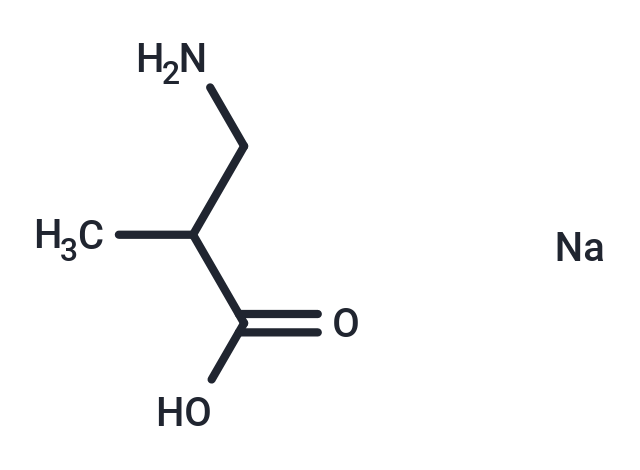- Remove All
 Your shopping cart is currently empty
Your shopping cart is currently empty
3-Aminoisobutyric Acid sodium
3-Aminoisobutyric acid, a non-protein amino acid resultant from thymine catabolism, plays a significant role in metabolic activities. At a 5 µM concentration, it triggers browning in primary adipocytes, notably elevating uncoupling protein 1 (UCP-1) and CIDEA expression. Additionally, it boosts PPARα expression in both primary adipocytes and mouse inguinal white adipose tissue (WAT) in vivo, alongside enhancing β-oxidation in hepatocytes. Its plasma levels surge post-exercise in mice, and its administration at 100 mg/kg daily curtails weight gain and body fat without diminishing food consumption or hiking energy output, whilst ameliorating glucose tolerance. Notably, 3-aminoisobutyric acid concentrations are heightened in individuals with β-ureidopropionase deficiency, a genetic flaw impairing pyrimidine degradation, affecting plasma, urine, and cerebrospinal fluid.

3-Aminoisobutyric Acid sodium
| Pack Size | Price | Availability | Quantity |
|---|---|---|---|
| 10 mg | Inquiry | 8-10 weeks | |
| 50 mg | Inquiry | 8-10 weeks |
Product Introduction
| Description | 3-Aminoisobutyric acid, a non-protein amino acid resultant from thymine catabolism, plays a significant role in metabolic activities. At a 5 µM concentration, it triggers browning in primary adipocytes, notably elevating uncoupling protein 1 (UCP-1) and CIDEA expression. Additionally, it boosts PPARα expression in both primary adipocytes and mouse inguinal white adipose tissue (WAT) in vivo, alongside enhancing β-oxidation in hepatocytes. Its plasma levels surge post-exercise in mice, and its administration at 100 mg/kg daily curtails weight gain and body fat without diminishing food consumption or hiking energy output, whilst ameliorating glucose tolerance. Notably, 3-aminoisobutyric acid concentrations are heightened in individuals with β-ureidopropionase deficiency, a genetic flaw impairing pyrimidine degradation, affecting plasma, urine, and cerebrospinal fluid. |
| Alias | β-Aminoisobutyric Acid, BAIBA |
| Molecular Weight | 125.1 |
| Formula | C4H8NO2?Na |
| Cas No. | 84796-61-2 |
| Storage | Powder: -20°C for 3 years | In solvent: -80°C for 1 year | Shipping with blue ice. |
Calculator
In Vivo Formulation Calculator (Clear solution)
Dose Conversion
Tech Support

Copyright © 2015-2025 TargetMol Chemicals Inc. All Rights Reserved.




